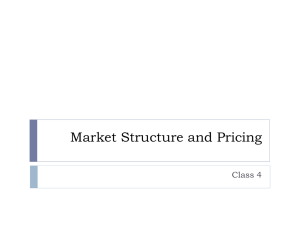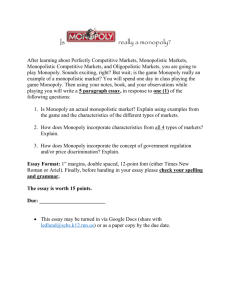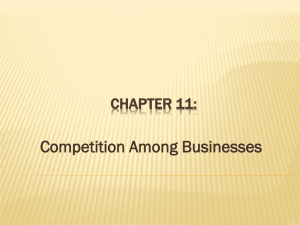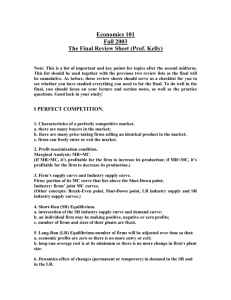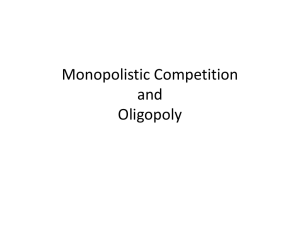review mon and after
advertisement
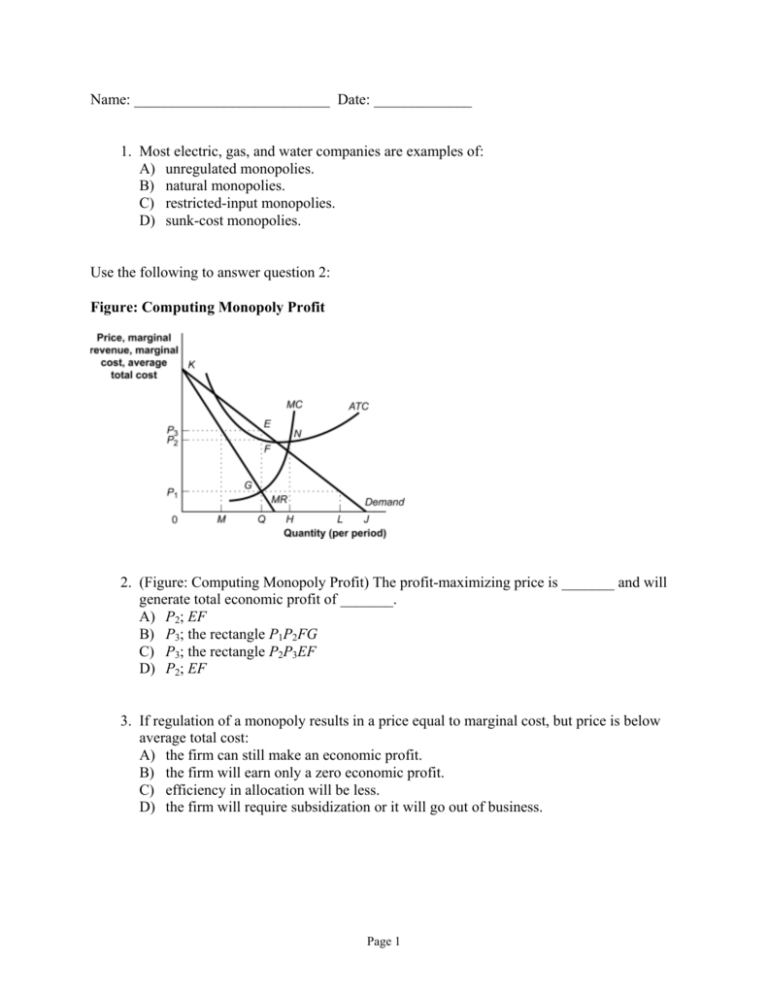
Name: __________________________ Date: _____________ 1. Most electric, gas, and water companies are examples of: A) unregulated monopolies. B) natural monopolies. C) restricted-input monopolies. D) sunk-cost monopolies. Use the following to answer question 2: Figure: Computing Monopoly Profit 2. (Figure: Computing Monopoly Profit) The profit-maximizing price is _______ and will generate total economic profit of _______. A) P2; EF B) P3; the rectangle P1P2FG C) P3; the rectangle P2P3EF D) P2; EF 3. If regulation of a monopoly results in a price equal to marginal cost, but price is below average total cost: A) the firm can still make an economic profit. B) the firm will earn only a zero economic profit. C) efficiency in allocation will be less. D) the firm will require subsidization or it will go out of business. Page 1 Use the following to answer question 4: Figure: Computing Monopoly Profit 4. (Figure: Computing Monopoly Profit) Producing at point N would: A) result in MR = MC. B) result in positive economic profits. C) never be profit maximizing, since at this output MR < 0 and MC > 0. D) result in the firm breaking even. Use the following to answer question 5: Figure: Monopoly Model Page 2 5. (Figure: Monopoly Model) When the firm is in equilibrium, its total revenue is the area of rectangle: A) SPDB. B) IPDH. C) 0SBJ. D) 0PDJ. 6. A demand curve that is downward sloping will ensure that: A) P = MR. B) P > MR. C) P < MR. D) P = MC. Use the following to answer question 7: Figure: Monopoly Model 7. (Figure: Monopoly Model) The profit-maximizing price is the one indicated by the distance: A) WZ. B) JD. C) KE. D) LF. Page 3 8. Suppose that a profit-maximizing monopoly firm experiences a substantial technological change that reduces its marginal and average total costs by $40. If in response to its reduction in cost, the firm changes its price in a profit-maximizing way, then we can predict that its total output will: A) rise. B) fall. C) remain unchanged. D) It is not possible to make a determination from the information given. 9. If a monopoly is forced to charge a price equal to marginal cost: A) output will fall. B) the deadweight loss will decrease. C) the monopoly will incur an economic loss. D) all of the above will occur. 10. A monopoly responds to a decrease in marginal cost by _______ price and _______ output. A) increasing; decreasing B) increasing; increasing C) decreasing; increasing D) decreasing; decreasing 11. Suppose that a monopoly firm is required to pay a new annual license fee just for the privilege of doing business in its fair city and that the fee is somewhat less than the economic profit the firm is now earning. In response to the increase in fees, the firm will: A) raise its price, but by less than the amount of the license fee. B) raise its price by the amount of the license fee. C) raise its price by somewhat more than the license fee. D) not change its price. 12. The demand curve facing a monopolist is: A) horizontal, the same as that facing a perfectly competitive firm. B) downward sloping, the same as that facing a perfectly competitive firm. C) upward sloping, the same as that facing a perfectly competitive firm. D) downward sloping, unlike the horizontal demand curve facing a perfectly competitive firm. Page 4 13. The demand curve for a monopoly is: A) the MR curve above the AVC curve. B) the MR curve above the horizontal axis. C) the entire MR curve. D) none of the above 14. Compared to perfect competition: A) monopoly produces less at a higher price. B) monopoly produces where MR = MC, and a perfectly competitively firm produces where P = MC. C) monopoly may have economic profits in the long run, but in perfect competition in the long run economic profits are zero. D) all of the above are true. 15. In a monopoly in the long run: A) economic profits will be eliminated by the entry of rival firms. B) economic profits will be reduced, but not eliminated entirely, by the entry of rival firms. C) entry will not occur. D) none of the above is true. 16. If your farm has the only known source of a rare cocoa bean needed to make chocolatecovered peanuts, your monopoly would result from: A) sunk costs. B) location. C) ownership of inputs. D) government restrictions. 17. To practice effective price discrimination, a monopolist must be able to: A) estimate its own production and cost functions. B) avoid detection by government regulatory agencies. C) prevent the resale of goods among groups of buyers. D) calculate the utility level of each buyer in the market. 18. The practice of selling the same product at different prices in different markets, without corresponding differences in costs, is: A) price discrimination. B) privatizing. C) monopolizing. D) output prioritizing. Page 5 19. The demand curve for a monopoly is: A) the sum of all the firm supply curves in the monopoly's industry. B) the industry demand curve. C) horizontal because no one can enter. D) perfectly elastic. 20. Because tourist demand for airline flights is relatively _______, small _______ in price will result in relatively _______ in additional tourists. A) price inelastic; reductions; very large increases B) price elastic; reductions; large increases C) price inelastic; increases; small decreases D) price elastic; increases; no change 21. Price discrimination leads to a _______ price in the market with a _______ demand. A) higher; more elastic B) higher; perfectly elastic C) lower; more elastic D) lower; less elastic 22. A natural monopoly exists whenever a single firm: A) is owned and operated by the federal or local government. B) is investor owned but has been granted the exclusive right by the government to operate in a market. C) confronts economies of scale over the entire range of production that is relevant to its market. D) has gained control over a strategic input of an important production process. 23. Which of the following is(are) true concerning monopoly? A) It is at the opposite end of the spectrum from a perfectly competitive firm. B) A monopoly has no rivals. C) A monopoly does not need to worry about other firms entering the industry. D) All of the above are true. 24. A monopoly responds to an increase in marginal cost by _______ price and _______ output. A) increasing; decreasing B) increasing; increasing C) decreasing; increasing D) decreasing; decreasing Page 6 25. Which of the following is(are) true? A) Profit-maximizing behavior is based on the marginal decision rule. B) Additional units of a good should be produced as long as MR > MC. C) The profit-maximizing solution occurs where MR = MC. D) All of the above are true. 26. A monopoly is a market characterized by a: A) product with no close substitutes. B) single buyer and several sellers. C) large number of small firms. D) small number of large firms. 27. Conditions that prevent the entry of new firms in a monopoly market are: A) barriers to entry. B) terms of sale. C) labor market stipulations. D) production controls. 28. A monopoly responds to an increase in demand by _______ price and _______ output. A) increasing; decreasing B) increasing; increasing C) decreasing; increasing D) decreasing, decreasing 29. Which of the following is(are) true? A) A monopoly firm is a price taker. B) MR > P if the demand curve is downward sloping. C) MR = MC is a profit-maximizing rule for any firm. D) All of the above are true. 30. The XYZ Company is a profit-maximizing firm with a monopoly in the production of pennants. The firm sells its pennants for $10 each. We can conclude that the XYZ Company is producing a level of output at which: A) average total cost equals $10. B) average total cost is greater than $10. C) marginal revenue equals $10. D) marginal cost equals marginal revenue. Page 7 Use the following to answer question 31: Figure: Monopoly Model 31. (Figure: Monopoly Model) The profit-maximizing quantity is the one indicated by the distance: A) 0W. B) 0J. C) 0K. D) 0L. 32. When one firm responds to a rival's cheating by cheating and to a rival's cooperation by cooperating, that firm is practicing a: A) dormant strategy. B) trigger strategy. C) conclusive strategy. D) tit-for-tat strategy. 33. When most cars sold in the United States were produced by the Big-Three auto companies, General Motors would announce its prices for the new model year first and then the other companies would match it. This practice was an example of: A) price leadership. B) noncooperative behavior. C) a kinked demand model. D) a cartel. Page 8 Use the following to answer questions 34-35: Figure: Monopoly Through Collusion 34. (Figure: Monopoly Through Collusion) For this question, assume that the duopoly industry illustrated in the figure produces a perishable good. If each firm acted on the belief that it faced demand curve D2 and acted without consideration of the other firm's behavior, the market price would likely end up being _______ and the combined economic profits of the firms would be _______. A) P1; given by the area of the rectangle bounded by 0P1CQ4 B) P1; zero C) P3; given by the area of the rectangle bounded by 0P3AQ1 D) P2; given by the area of the rectangle bounded by P1P2GB 35. (Figure: Monopoly Through Collusion) The figure illustrates the situation in an industry that consists of two firms facing identical demand curves; the demand curve for each firm is D1. If the firms collude and agree to share the market demand equally, then each firm will act as if its demand curve is given by: A) D1. B) D2. C) MR1. D) 2 × D1. 36. The percentage of total industry sales accounted for by the four largest firms in the industry is the: A) four-firm concentration ratio. B) four-firm employment rate. C) four-firm sales index. D) four-firm market number. Page 9 37. A cartel is an example of: A) price extortion. B) price leadership. C) overt collusion. D) tacit collusion. Use the following to answer question 38: Figure: Monopoly Through Collusion 38. (Figure: Monopoly Through Collusion) Given the duopoly industry illustrated in the figure, if the two firms colluded to maximize their combined economic profits, the market price they would set would be _______ and combined economic profits of the firms would be _______. A) P1; given by the area of the rectangle bounded by 0P1CQ4 B) P1; zero C) P3; given by the area of the rectangle bounded by 0P3AQ1 D) P2; given by the area of the rectangle bounded by P1P2BG 39. In general, the higher the concentration ratio in an industry, the: A) greater the ratio of MC to ATC. B) lower the ratio of MC to ATC. C) less firms need to pay attention to individual rivals. D) more firms need to pay attention to individual rivals. Page 10 Use the following to answer question 40: Figure: Monopoly Through Collusion 40. (Figure: Monopoly Through Collusion) The figure illustrates the situation in an industry that consists of two firms facing identical demand curves; the demand curve for each firm is D1. If the firms collude and agree to share the market demand equally, then each firm will act as if its marginal revenue curve is given by: A) MR1. B) 2 MR1. C) MR2. D) MC. 41. The cable TV market has only two firms, CableNorth and CableSouth. Through tacit collusion, they each arrive at an equilibrium price and quantity and see their demand curve as kinked. Any increase in marginal cost: A) will encourage both firms to produce less. B) may encourage both firms to produce more. C) will encourage both firms to charge a higher price. D) will do none of the above. Page 11 Use the following to answer question 42: Figure: Monopoly Through Collusion 42. (Figure: Monopoly Through Collusion) Given the duopoly industry illustrated in the figure, if each firm acted on the belief that it faced demand curve D2 and acted without consideration of the other, each firm would attempt to maximize economic profits by producing quantity _______ and setting price equal to _______. A) Q4; P1 B) Q4; P2 C) Q1; P4 D) Q2; P2 43. A well-known example of an international cartel is: A) Japan. B) OPEC. C) Exxon. D) General Motors. 44. Oligopoly is a market structure characterized by: A) independence in decision making. B) a horizontal demand curve. C) a small number of interdependent firms. D) relatively easy entry and exit. Page 12 45. Suppose that each of two prisoners has the independent choice of confessing to a crime or not confessing. If neither confesses, they spend 2 years in jail; if both confess, they spend 3 years in jail; and if one confesses while the other does not, the confessor gets off with 1 year in jail while the other gets 6 years in jail. According to game theory, the likely strategy by the prisoners is: A) both will confess. B) neither will confess. C) one will confess and the other will not. D) both may or may not confess. Use the following to answer question 46: Figure: Pricing Strategy in Cable TV Market 2 46. (Figure: Pricing Strategy in Cable TV Market 2) The Nash equilibrium in the cable TV market is when: A) both firms set a low price and each earns $90,000 per month. B) both firms set a high price and each earns $100,000 per month. C) CableNorth sets a high price and earns $80,000 per month, while CableSouth sets a low price and earns $130,000 per month. D) CableNorth sets a low price and earns $130,000 per month, while CableSouth sets a high price and earns $80,000 per month. Page 13 Use the following to answer question 47: Figure: Monopoly Through Collusion 47. (Figure: Monopoly Through Collusion) The figure illustrates the situation in an industry that consists of two firms facing identical demand curves; the demand curve for each firm is D1. Which of the following assumptions is not a part of the analysis illustrated by the model? A) The two firms are identical. B) The two firms sell identical products. C) While the firms face the same MC curves, their respective TC curves have unequal slopes. D) Each firm has a horizontal marginal cost curve. 48. An oligopoly knows that its _______ affect(s) its _______ and that the _______ of its rivals will affect it. A) actions; rivals; reactions B) price changes; total revenue in a positive way; reactions C) actions rarely; rivals; actions D) price increases; total revenue in the long run only; large but not small price changes 49. OPEC is: A) the Organization of Petroleum Exporting Countries. B) an international cartel made up of oil-producing countries. C) the cartel that was responsible for the large increases in crude oil prices in the 1970s. D) described by all of the above. Page 14 50. The cable TV market has only two firms, CableNorth and CableSouth. Through tacit collusion, they each arrive at an equilibrium price and quantity and see their demand curve as kinked. CableNorth will be reluctant to lower its price because it sees that portion of the demand curve as _______ and if it lowered price, total revenue would ________. A) price elastic; fall B) price inelastic; fall C) price elastic; rise D) price inelastic, rise 51. An industry dominated by a few firms, where each of those firms recognizes that its own choices will affect the choices of its rivals and that its rivals' choices will affect it, is a(n): A) monopoly. B) oligopoly. C) monopolistic competition. D) perfect competition. Use the following to answer question 52: Figure: Monopoly Through Collusion 52. (Figure: Monopoly Through Collusion) This figure shows: A) game theory and oligopoly behavior. B) the prisoner's dilemma. C) how two identical firms could collude to maximize joint profits. D) how to measure the four-firm concentration ratio using demand, marginal revenue, and marginal cost curves. Page 15 53. When firms openly agree on price, output, and other decisions aimed at achieving monopoly profits, those firms are practicing: A) overt collusion. B) tacit collusion. C) leadership price. D) competitive game. Use the following to answer question 54: Figure: Pricing Strategy in Cable TV Market 2 54. (Figure: Pricing Strategy in Cable TV Market 2) If the two firms in the cable TV market collude then: A) CableNorth will set a high price and earn $80,000 per month, while CableSouth will set a low price and earn $130,000 per month. B) CableNorth will set a low price and earn $130,000 per month, while CableSouth will set a high price and earn $80,000 per month. C) both firms will set a low price and each will earn $90,000 per month. D) both firms will set a high price and each will earn $100,000 per month. Page 16 Use the following to answer question 55: Figure: Monopoly Through Collusion 55. (Figure: Monopoly Through Collusion) Given the industry illustrated in the figure, the efficient solution is found where price is _______ and quantity is _______. A) P1; Q4 B) P2; Q2 C) P2; Q1 D) P3; Q1 Use the following to answer question 56: Figure: Pricing Strategy in Cable TV Market 1 Page 17 56. (Figure: Pricing Strategy in Cable TV Market 1) If both CableNorth and CableSouth advertise, then without any collusion: A) CableNorth will stop advertising to maximize profits. B) CableSouth will stop advertising to maximize profits. C) there will be no tendency for either CableNorth or CableSouth to stop advertising. D) there is a tendency for both CableNorth and CableSouth to stop advertising. Use the following to answer question 57: Figure: Pricing Strategy in Cable TV Market 2 57. (Figure: Pricing Strategy in Cable TV Market 2) The dominant strategy for CableSouth: A) is to charge a high price. B) is to charge a low price. C) is to charge what CableSouth does. D) does not exist. 58. A strategy that is the same regardless of the action of the other player in a game is said to be a: A) competitive strategy. B) trigger strategy. C) dominant strategy. D) tit-for-tat strategy. 59. Oligopoly is a market structure characterized by: A) independence in decision making. B) uncertainty about the behavior of rival firms. C) substantial diseconomies of scale. D) a large number of small firms. Page 18 60. A concentration ratio is used to measure: A) efficiency. B) diseconomies of scale. C) marginal cost. D) market dominance. Use the following to answer question 61: Figure: Pricing Strategy in Cable TV Market 2 61. (Figure: Pricing Strategy in Cable TV Market 2) The dominant strategy for CableNorth: A) is to charge a high price. B) is to charge a low price. C) is to charge what CableSouth does. D) does not exist. Use the following to answer questions 62-63: Figure: The Restaurant Market Page 19 62. (Figure: The Restaurant Market) The figure shows curves facing a typical restaurant in a community. Assume that many firms, differentiated products, and easy entry and easy exit characterize the market. In long-run equilibrium, the economic profit earned by the typical restaurant in the community will be: A) negative. B) zero. C) equal to the level shown in the figure. D) Not enough information is given to answer the question. 63. (Figure: The Restaurant Market) The figure shows curves facing a typical restaurant in a community. Assume that many firms, differentiated products, and easy entry and easy exit characterize the market. For the restaurant shown here, its profit per unit is: A) ae. B) fd. C) bf. D) bd. Use the following to answer question 64: Figure: Profit Maximization for a Firm in Monopolistic Competition 64. (Figure: Profit Maximization for a Firm in Monopolistic Competition.) Suppose that an innovation reduces a firm's fixed costs and reduces cost from ATC to ATC'. After the innovation reduced the cost, the firm's maximum economic profit is: A) $0. B) $30. C) $1,500. D) $3,000. Page 20 65. An industry characterized by many firms, producing similar but differentiated products, in a market with easy entry and exit is called: A) perfect competition. B) monopoly. C) monopolistic competition. D) oligopoly. 66. In the long run, monopolistically competitive firms tend to experience: A) high economic profits. B) zero economic profits. C) negative economic profits. D) substantial economic losses. Use the following to answer question 67: Figure: Firms in Monopolistic Competition 67. (Figure: Firms in Monopolistic Competition) Negative economic profit or economic loss is incurred if the profit-maximizing price is price _______ in Panel _______. A) 0G; A B) 0H; B C) 0I; C D) 0J; C 68. Due to the existence of a large number of similar, but not identical, substitutes in most communities, the market for chiropractors is best considered: A) an oligopoly. B) perfect competition. C) monopolistic competition. D) a monopoly. Page 21 Use the following to answer question 69: Figure: Profit Maximization in Monopolistic Competition 69. (Figure: Profit Maximization in Monopolistic Competition) In the short run, a firm in monopolistic competition may experience economic profits as shown in Panel A: A) PS. B) PS times the quantity 0M. C) PS times the quantity 0Q. D) PT times the quantity 0Q. 70. A feature of monopolistic competition that makes it different from monopoly is the: A) fact that firms in the model of monopolistic competition follow the marginal decision rule while monopolies do not. B) downward-sloping demand curve. C) downward-sloping marginal revenue curve. D) number of firms in the industry. 71. Which of the following is(are) true? A) When choosing the profit-maximizing quantity, the short-run decision making process for a firm in perfect competition and a firm in monopolistic competition is the same, since they produce the quantity where MR = MC. B) In the long run in perfect competition economic profits = 0, and in monopolistic competition in the long-run economic profits are = 0. C) In perfect competition P = MC and in monopolistic competition, MR = MC, but P > MC and there is excess capacity. D) All of the above are true. Page 22 72. The model of monopolistic competition can characterize the market for plumbing services in a city. Suppose that the market is initially in long-run equilibrium, and then there is an increase in demand for plumbing services. We expect that in the short run the price: A) and output of plumbing services will fall. B) and output of plumbing services will remain unchanged. C) and output of plumbing services will rise. D) of plumbing services will rise and the output will fall. 73. The demand curve for a firm under monopolistic competition is: A) downward sloping, unlike the horizontal demand curve facing a perfectly competitive firm. B) horizontal, unlike the downward-sloping demand curve facing a perfectly competitive firm. C) horizontal, the same as that facing a perfectly competitive firm. D) downward sloping, the same as that facing a perfectly competitive firm. 74. Product differentiation under monopolistic competition means that each firm: A) charges slightly different prices. B) has a pure monopoly. C) maximizes profit where MC = P. D) faces a horizontal demand curve. Use the following to answer question 75: Figure: Firms in Monopolistic Competition Page 23 75. (Figure: Firms in Monopolistic Competition) Economic profit is earned if the profitmaximizing price is price _______ in Panel _______. A) 0F; A B) 0G; A C) 0H; B D) 0I; C 76. Due to the existence of a large number of similar, but not identical, substitutes in most communities, the market for financial planners is best considered: A) a monopoly. B) an oligopoly. C) perfect competition. D) monopolistic competition. 77. One advantage of brand names is that: A) they provide some assurance of consistency of quality. B) they convey information about the nature of the product. C) they indicate that the seller is engaged in repeated interaction with its customers. D) they do all of the above. Use the following to answer question 78: Figure: Profit Maximization in Monopolistic Competition Page 24 78. (Figure: Profit Maximization in Monopolistic Competition) If other firms see economic profits in the industry, they will enter it, and the demand curve for firms already in the industry will shift to the ________; in the long run, this will result in economic profit _______ and price _______. A) right; = 0; = ATC B) right; > 0; > ATC C) left; < 0; < ATC D) left; = 0; = ATC 79. Which of the following is(are) true? A) Perfect competition is a goal toward which an economy should strive. B) Monopolistic competition results in excess capacity, since in the long run MR = MC is to the left of the minimum of the ATC curve. C) One might characterize monopolistic competition as an industry, such as gasoline stations, which in the long run does not experience economic profits. D) All of the above are true. Use the following to answer questions 80-81: Figure: Firms in Monopolistic Competition 80. (Figure: Firms in Monopolistic Competition) Zero economic profit is earned if the profit-maximizing price is price _______ in Panel _______. A) 0F; A B) 0G; A C) 0H; B D) 0I; C Page 25 81. (Figure: Firms in Monopolistic Competition) In Panel B, the profit-maximizing quantity of output is generated by the intersection at point: A) Q. B) R. C) S. D) T. Use the following to answer question 82: Figure: Profit Maximization in Monopolistic Competition 82. (Figure: Profit Maximization in Monopolistic Competition) In monopolistic competition, long-run equilibrium is characterized by: A) P > MR. B) P < MR. C) P = MR. D) profit maximization, which occurs where P = MR = MC. 83. Which of the following is(are) correct about celebrity spokespersons advertising products? A) Celebrities are better informed about the relative merits of different products than the rest of us. B) Celebrity advertising signals consumers that the product is reliable, because the firm is willing to pay the high fees associated with hiring a celebrity. C) Consumers assume that the celebrity has researched the product and that the claims being made on his or her behalf are true. D) All of the above are true. Page 26 84. In large shopping areas, the retail market is most illustrative of: A) monopolistic competition. B) monopoly. C) perfect competition. D) perfect oligopoly. 85. The demand curve for a firm under monopolistic competition is: A) U-shaped. B) upward sloping. C) downward sloping. D) vertical. 86. When the profit-maximizing level of output is less than the output associated with the minimum possible average total cost of production, a firm is said to have: A) economic profits. B) excess capacity. C) advertising. D) excess production. 87. The excess capacity in monopolistic competition may be viewed as: A) the cost of product diversity. B) efficient. C) the reason P = MR = MC in monopolistic competition. D) all of the above. Use the following to answer question 88: Figure: Profit Maximization in Monopolistic Competition Page 27 88. (Figure: Profit Maximization in Monopolistic Competition) In Panel A, if the firm raises its price above P, it will: A) lose all its customers. B) still have some customers. C) not lose any customers. D) have none of the above occur. 89. Assuming identical production functions and cost curves, the long-run equilibrium of a monopolistically competitive firm, as compared with that of a perfectly competitive firm, is such that, for the former, price is: A) higher and output is greater. B) higher and output is smaller. C) lower and output is greater. D) lower and output is smaller. Use the following to answer question 90: Figure: Firms in Monopolistic Competition 90. (Figure: Firms in Monopolistic Competition) In Panel A, economic profit per unit is amount: A) KL. B) LM. C) MN. D) NO. 91. Product differentiation under monopolistic competition means that each firm: A) charges the same price. B) maximizes profit where MC = P. C) faces a downward-sloping demand curve. D) receives economic profits. Page 28 92. The main characteristic that distinguishes monopolistic competition from perfect competition is: A) easy entry and exit. B) many firms. C) differentiated products. D) to maximize profits, a firm will produce where MR = MC. Use the following to answer question 93: Figure: The Restaurant Market 93. (Figure: The Restaurant Market) The figure shows curves facing a typical restaurant in a community. Assume that many firms, differentiated products, and easy entry and easy exit characterize the market. The restaurant shown here will maximize profits at a quantity of: A) Q1. B) Q2. C) Q3. D) There is not enough information given to answer the question. 94. Defenders of advertising argue that it: A) seeks to persuade, rather than inform, buyers. B) provides education and information about products. C) facilitates the concentration of monopoly power. D) encourages artificial product differentiation. Page 29 95. The profit-maximizing rule MC = MR is followed by firms under: A) monopolistic competition, but not perfect competition. B) perfect competition, but not monopolistic competition. C) either monopolistic competition or perfect competition, depending on the costs of production. D) both monopolistic competition and perfect competition. 96. If a firm under monopolistic competition is producing a quantity that generates MC < MR, then the marginal decision rule tells us that profit: A) can be increased by increasing production. B) can be increased by decreasing production. C) can be increased by increasing the price. D) is maximized only if MC = P. Page 30 Answer Key 1. 2. 3. 4. 5. 6. 7. 8. 9. 10. 11. 12. 13. 14. 15. 16. 17. 18. 19. 20. 21. 22. 23. 24. 25. 26. 27. 28. 29. 30. 31. 32. 33. 34. 35. 36. 37. 38. 39. 40. 41. 42. 43. 44. B C D C D B B A B C D D D D C C C A B B C C D A D A A B C D B D A B A A C D D A D D B C Page 31 45. 46. 47. 48. 49. 50. 51. 52. 53. 54. 55. 56. 57. 58. 59. 60. 61. 62. 63. 64. 65. 66. 67. 68. 69. 70. 71. 72. 73. 74. 75. 76. 77. 78. 79. 80. 81. 82. 83. 84. 85. 86. 87. 88. 89. 90. A A C A D B B C A D A C B C B D B B C C C B D C C D D C A A A D D D D C C A B A C B A B B B Page 32 91. 92. 93. 94. 95. 96. C C B B D A Page 33




